Chinese metal in ancient Japan (part of 7)
(Sirah 34: 10)
"... gold, silver, copper, iron, tin and lead, ..."
(31 numbers: 22)
More than once or twice in the materials of a series of articles on metals of the Bronze Age, we met with the statements of scientists that the technology of metal processing in a particular region was brought by immigrants from other lands, that is, the problem of ancient migrants is also a problem of ancient metallurgy. . And in general, no one argues with this. However, when it comes to specific regions, there are a lot of “yes” and “no” in support of this point of view.
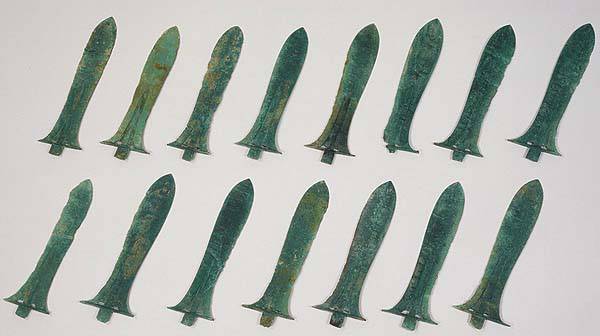
Ritual weapon from bronze (period Yayoi). Tokyo National Museum.
And here we are come to the aid of spectral analysis, which allows, with perfect precision, to answer the question of what metal and with what impurities this object was made. Moreover, just by adding various ancestors to more or less pure copper, our ancestors received the world's first artificial alloy - bronze, from the name of which the term “bronze age” originated.
Well, the property of the same tin and lead is such that they lower the melting point of copper, increase its fluidity, greatly facilitate the process of casting and final processing of objects, and also change the color of the product. If the content of tin in the bronze alloy is higher than 10%, then the characteristic reddish-copper color of the metal turns into brass-yellow, and when the content of tin in it is reduced to 30% or more, it becomes silvery-white. If the lead in the melt is less than 9%, then it is fused into a homogeneous mass, but with its high content of lead, it is released from it during the cooling process and deposited on the walls of the melting crucible or form.
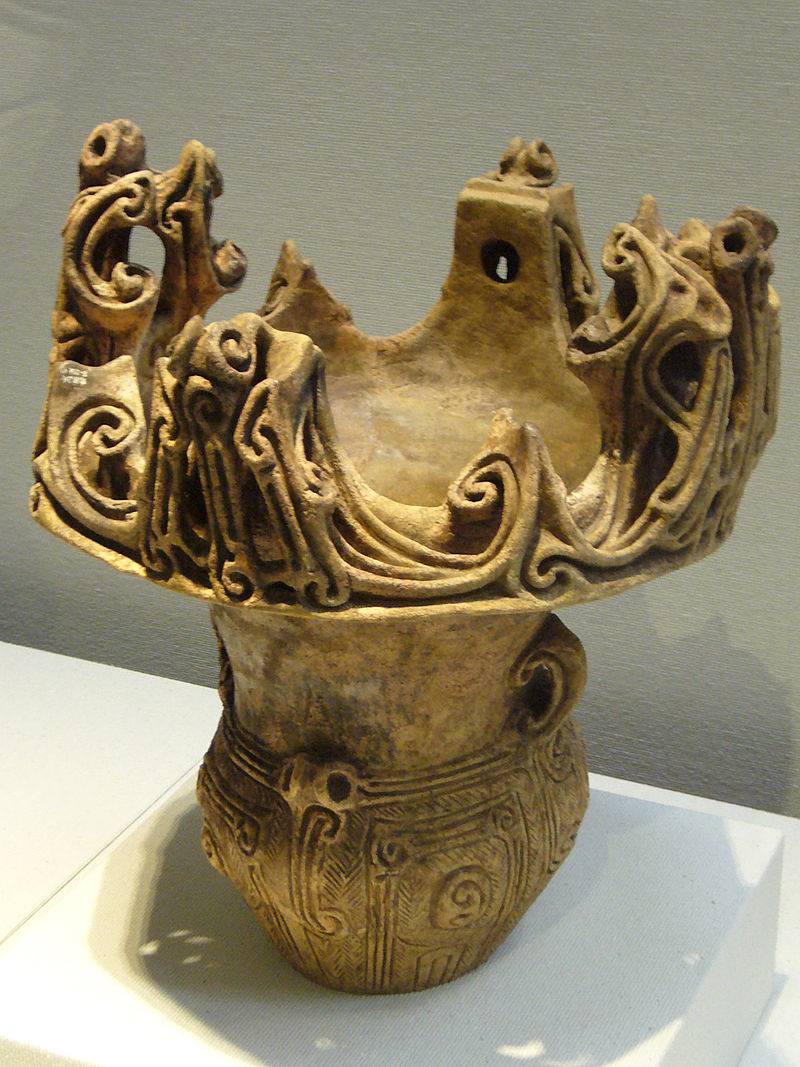
"The vessel with the crown" (3000 - 2000 years. BC). Jomon period. Tokyo National Museum.
The dominance of casting determined the composition of the alloy, in which the ancient Chinese consisted of three main components - copper (tun), tin (Xi) and lead (qian), the ratio of which could vary depending on time and the place of manufacture of the product. So, copper in ancient Chinese bronze could be from 63,3 to 93,3%, tin - from 1,7 to 21,5% and lead - from 0,007 to 26%. In addition to these metals, in Yin bronze alloys an impressive set of various components was also found, including zinc (blue, 0,1-3,7%), iron (those less than 1%), which in small doses affects the color of the product and gives it a yellowish tint , nickel (not, approx. 0,04%), cobalt (gu, 0,013%), bismuth (bi, 0,04%), as well as antimony (ty), arsenic (shen), gold (jin) and silver (yin) however, in microscopic doses. As organic additives, bone-ash containing phosphorus was used, which served as a deoxidizing agent (i.e., neutralized the oxidation process), and improved the ductility of the alloy. The bronze casting process consisted of three consecutive technological operations: making a model together with a form, smelting and casting. Charcoal was used as fuel, capable of providing a melting point in 1000º. The technology mastered in the second half of the Shang-Yin epoch made it possible to cast highly intricate configurations and with bronze weights almost a ton and carry out the most complex ornamental compositions on them.
Yodokhara village in Kagoshima, reconstruction of the village of the Jomon period.
That is, the composition of the metal, found in different places, is its unique passport. It is enough to compare the data of the spectral analysis of two seemingly completely different products, but made of the same metal in the same workshop, to say that “they are relatives”!
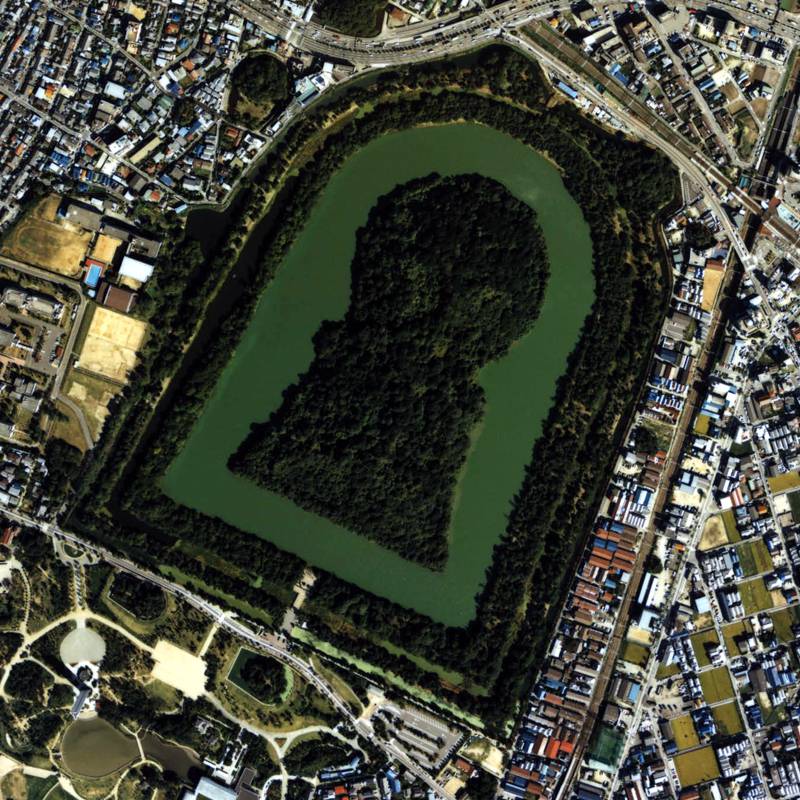
The whole territory of Japan is covered with large or small "keyholes" (there are more than 161560 in total!) - the burial mounds of the Kofun, the Kofun era, the first sub-period of the Yamato era. Digging them out is prohibited by law. But this is the largest kofun - daisen-kofun, the tomb of Emperor Nintoku in Osaka, view from an airplane.
That is, the composition of the metal, found in different places, is its unique passport. It is enough to compare the data of the spectral analysis of two seemingly completely different products, but made of the same metal in the same workshop, to say that “they are relatives”! Moreover, in the past it often happened that metal, and in particular the same bronze products, turned out to be many hundreds, or even thousands of kilometers away from the places of their manufacture, and not just turned out, but also created new civilizations, as it happened, for example, Japan
The bronze dotaku bell is one of the most popular types of casting in Japan at the end of the Yayoi III century. AD Tokyo National Museum.
I must say that story Japan contains many secrets. Moreover, at least one of them is connected with the history of all mankind and, in addition, again with the history of the oldest metal.
Let's start with the fact that modern archeology has reliable data that people lived there already 40 thousands of years ago, that is, in the era of the Upper Paleolithic. At that time, the level of the oceans was 100-150 meters below the modern and the Japanese islands were part of the Asian mainland. 12 thousands of years ago, the glacial period ended, and it reached its present level. The climate has become warmer and the Japanese flora and fauna have changed dramatically. Oak and coniferous forests grew in the northeastern part of the archipelago, and in the southwestern part, beech and subtropical forests. They contained large boars, deer, wild ducks, and pheasants, and the coastal areas were rich in clams, salmon and trout. Due to this natural wealth, the inhabitants of the Japanese islands did not require large-scale farming, and they continued to engage in hunting and gathering.
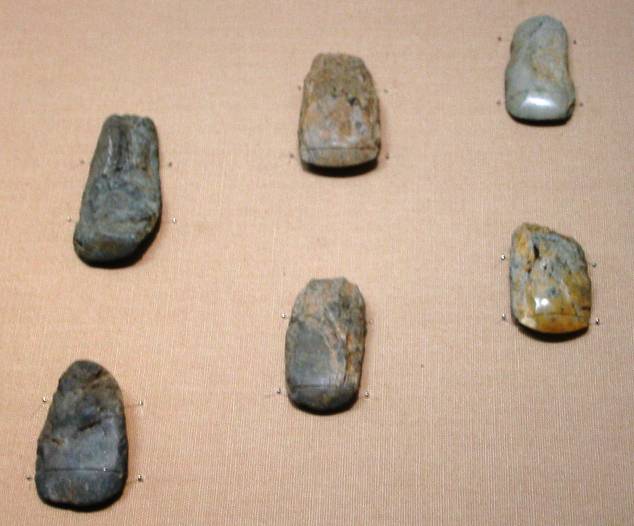
Polished stone axes aboriginal Japanese islands. Tokyo National Museum.
At about the same time, according to historians, the first migration of migrants from Southeast Asia to the Japanese islands occurred. And already about 10 thousands of years ago, the ancient inhabitants of the Japanese islands took possession of the secrets of ceramic production, and began to make ceramic products, which are considered among the oldest in the world. Among them, kitchenware in the form of jugs for storing food and cooking, as well as ritual human-like figurines called dogu prevailed. Since the main feature of these ceramics was the so-called “lace ornament” (Jomon in Japanese), archaeologists called this culture “Jomon culture”, and the era when it dominated the Japanese islands was the Jomon period.
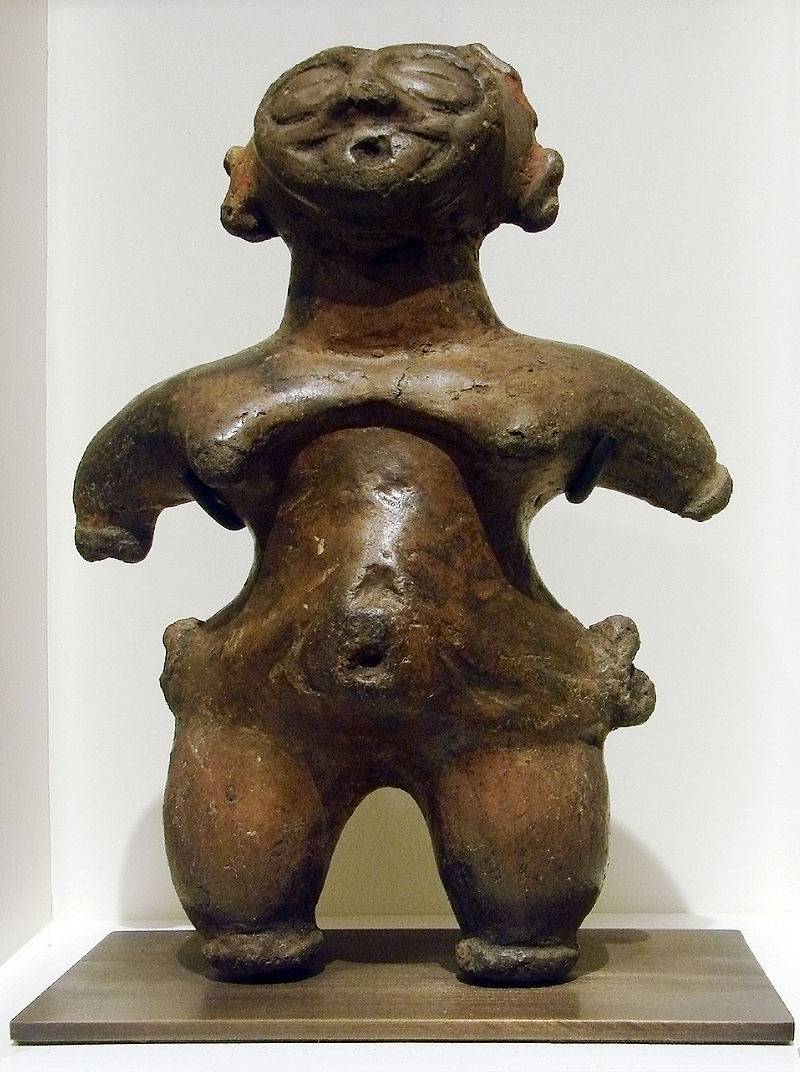
Dogo statuette. Jomon culture Guimet Museum, Paris.
Then, in 1884, in Japan, they found ceramics of a new style, and in honor of the first site, where artifacts of a new style were discovered, this new archaeological culture was given the name “Yayoi culture”. Modern historiography considers that the Yayoi era began in the III century BC, and ended only in the III century AD, although a number of modern Japanese researchers attribute its beginning five hundred years earlier - in the IX century BC, based on radiocarbon data and spectrometry results.
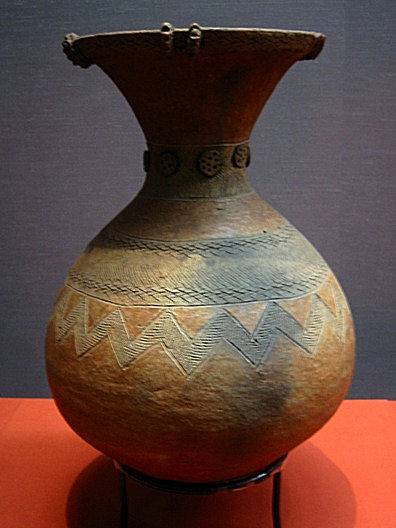
Vessel era Yayoi.
Well, the reason was still the same - migrants from China: a massive flow of immigrants who did not want to recognize the power of the Han dynasty. At the same time, these migrants from China and Korea brought to the Japanese islands not only rice-growing equipment, and more advanced agricultural tools, but also bronze and even iron products, which were not available before that, and also the processing technology of these metals. At the same time, life on the islands changed radically, craft and agriculture began to develop, and the general level of culture also increased significantly.
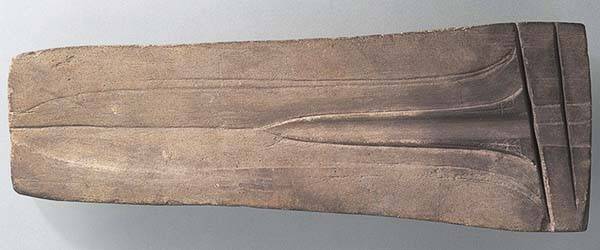
Ancient stone mold for casting from bronze.
Of course, in the first place it was a weapon that in the era of the Yin dynasty was represented by bronze axes of Yue, which had the shape of a trapezoid with a moon-shaped blade. Blow such an ax could easily cut off a man’s head or cut him in half. Therefore, they were used both as a military weapon, and as an instrument of execution, and even ... as a musical percussion instrument. Among the royal regalia of the Yin era, there was also such an ax, and there is even a version that the hieroglyph “king” (van) is derived from the image of the ax Yue. It is indicative that the axes are often found in the graves of the Yin nobility, and therefore they had a rich decoration, embossed and transparent decor, including also images of people and animals.
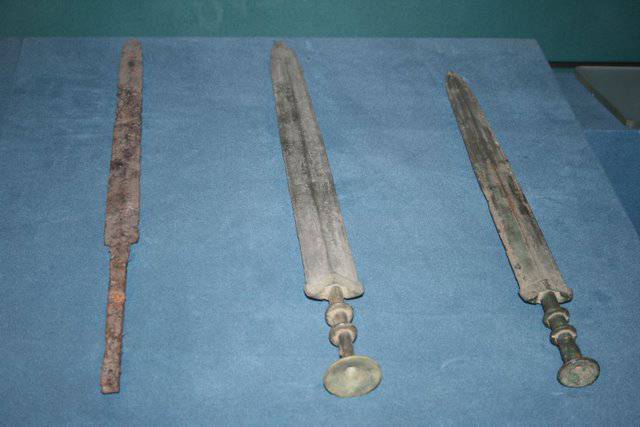
Chinese swords: iron on the left and two bronze on the right.
But in the XI-VIII centuries. BC. the ax is completely out of fashion. And it was replaced mainly by a halberd-chi with a pointed beak-like tip on a long wooden shaft.
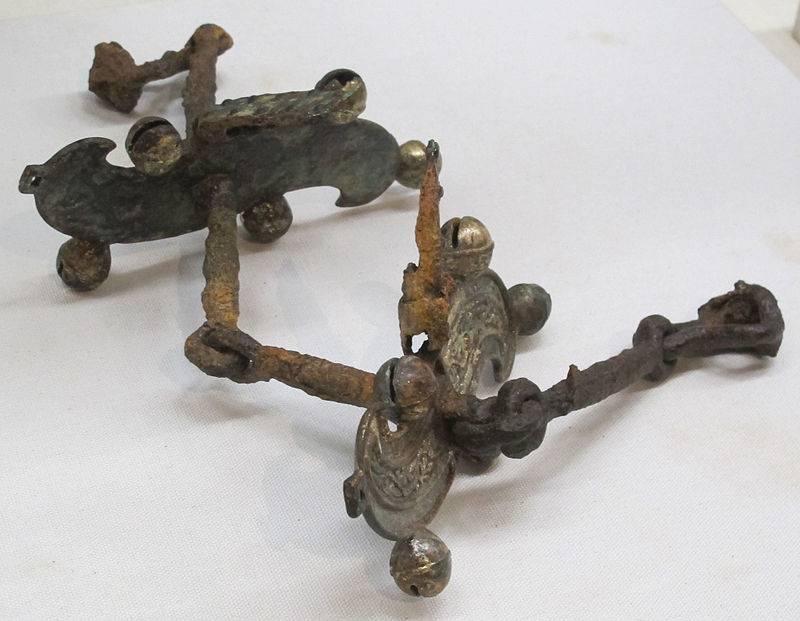
Bronze bits of the Kofun era, V - VI centuries. AD
In the VIII-VII centuries. BC. in China, sword-jian appeared, and in two constructive versions at once: a “short” blade from 43 to 60 cm in length, and “long” up to one meter. "Short swords" were the most popular type of both military and ceremonial weapons. In the burials of V-III centuries. BC. There are whole arsenals in which such swords are found before 30. Most of the known finds have cast handles with decorative inlays of mother-of-pearl and jade, and their blades are often decorated with gold inlay. And then it was with the people of Japanese culture that Yayoi met all this and quickly adopted it all.
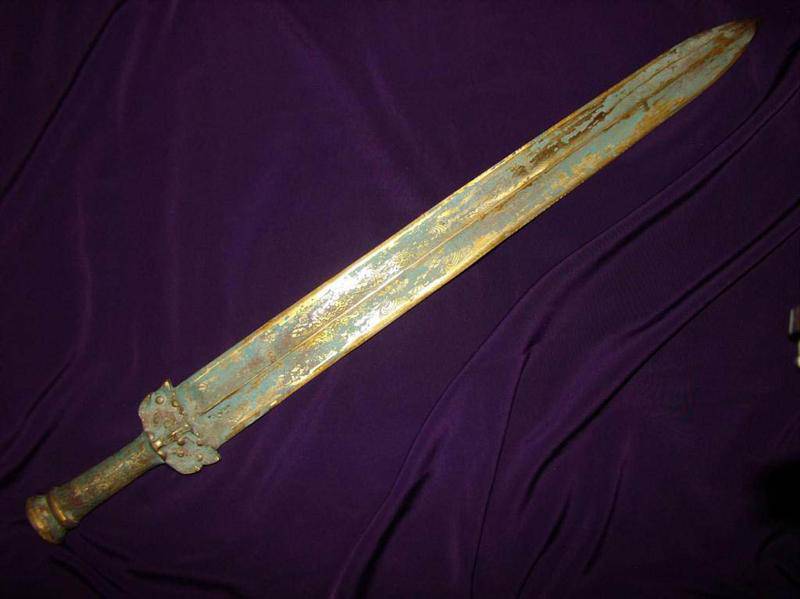
Chinese sword jian.
Well, the Japanese themselves very soon began not only to mine copper and get alloys close to bronze, but more often ... just melt down the old Chinese bronze products, which confirms their comparative chemical analysis. And in Japan, the Yayoi period, as well as in China, made weapons, objects of worship and jewelry from bronze. The population began to increase, there was not enough land for the fields, and as a result, long and bloody wars began with the aboriginal population of the Japanese islands - the Ainu, which became the basis for the development of Japanese statehood and all subsequent Japanese culture. That is, in Japan there was no copper-stone age, and bronze and iron were processed here almost simultaneously.
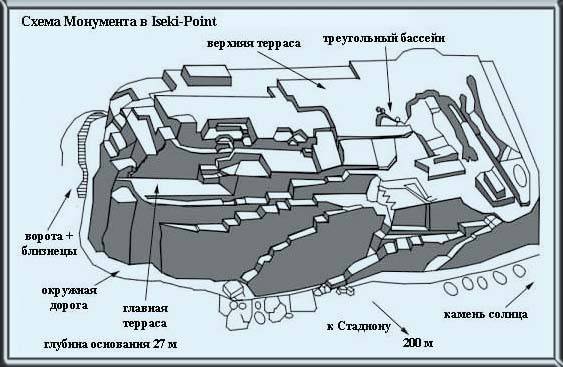
Yonaguni Monument.
And now how the history of the ancient Japanese metal is connected with the history of all mankind. It turns out to be the most direct, although there is almost nothing about the metal itself. The fact is that in 1985, in the waters of the Japanese island of Yonaguni, an underwater artifact of clearly man-made origin was discovered, called the Yonaguni Monument. The dimensions of the artifact are 50 meters long, 20 meters wide, and 27 meters high from the base. Fans of loud sensations immediately dubbed it a “pyramid”, determined that it was an alien space center, the “temple of Atlanteans,” but the whole thing is that this is not a pyramid, and, most likely, not a temple, as the surface monument "is such that most of all resembles ... modern mining production for the extraction of stone! There are wide flat platforms covered with an ornament of hand-carved huge rectangles and rhombuses, and intricate terraces cascading down in large steps and many unnaturally straight edges. It seemed that the structural elements have a clear architectural composition, but it is meaningless from all points of view, except for one - once a long time ago a stone was taken here and all these “steps” and “corners” are consequences of the work on its mining. That is, it is nothing like an ancient stone quarry. Hence the whole intricacy of its architecture.
It’s hard to say how true this statement is, but the conclusion that the megalith of Yonaguni is a trace of an ancient civilization was supported by most Japanese scientists in 2001 year. Moreover, in something similar to the Yonaguni Monument, a giant stepped structure was also found on Chatan Island in Okinawa; An unusual underwater labyrinth near the island of Kerama was discovered, and clearly cylindrical recesses made by human hands were found near the island of Aguni. On the other side of the island of Yonaguni, in the strait between Taiwan and China, they found underwater structures similar to walls and roads ... And although all this has already been found for a long time, the research of all these underwater objects is in fact just beginning. Although despite the obvious lack of information, we can already talk about the existence in the area of the Japanese islands of an ancient and developed megalithic civilization, about which historians previously knew nothing, and which existed even before all these structures were flooded by sea waves, that is over 12 thousands of years ago. And another interesting thing: if we assume that this is an ancient stone quarry, then what tools of labor worked on it? Stone, like those used by the natives of Easter Island for the manufacture of their stone moai idols, or metal, made of copper and bronze, similar to the tools of the ancient Egyptians? In the first case, we get an impressive example of antediluvian culture of the Stone Age. But in the second - if only artifacts from copper or bronze of the corresponding time are found there, then it will immediately become obvious that the very first metal did not appear at all in Chatal-Hyuyuk, but somewhere here, and even before all these ancient buildings flooded the oceans! And then the whole world history will have to be rewritten! It is not clear, however, for the time being one circumstance: for the construction of which “objects” was the construction material used, extracted here in such a huge amount ...
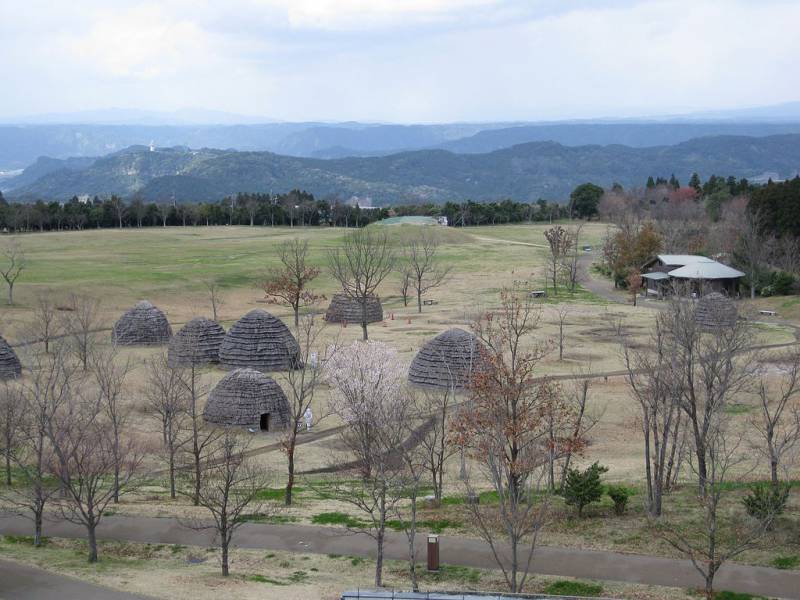
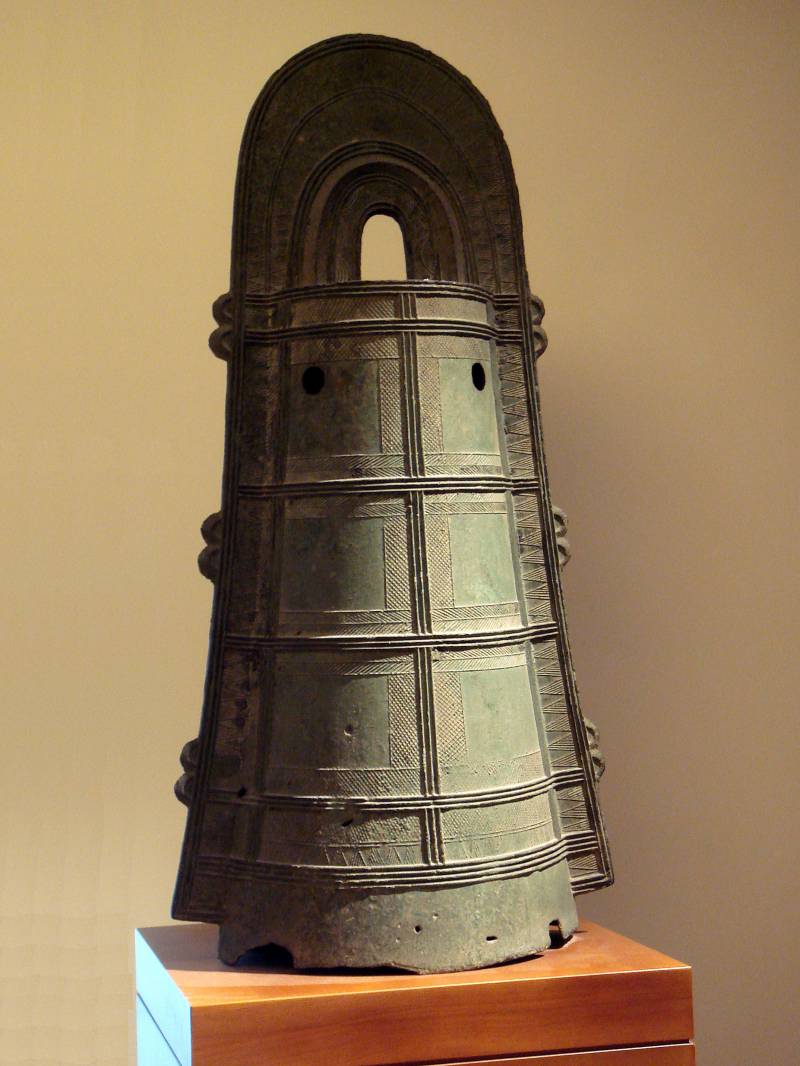
Information